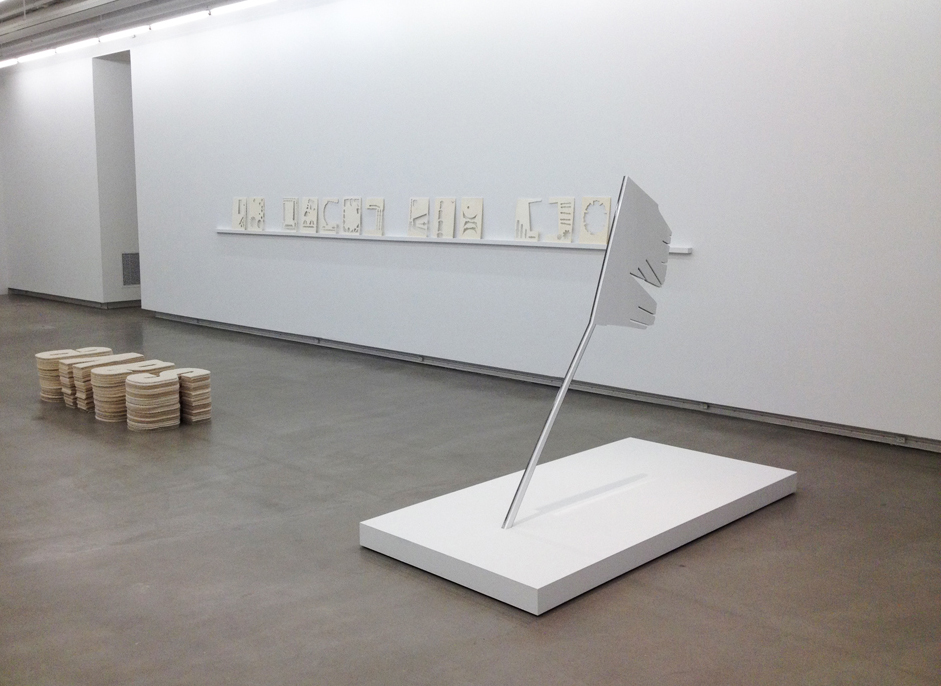GROUP & COLLABORATION
Superimposition: Sculpture and Image
Nadia Belerique, Valérie Blass, Ursula Johnson, Kelly Lycan, Ursula Mayer, Kristin Nelson, Dominique Rey and Andrea Roberts
- October 1, 2016 to January 1, 2017
- Plug-In Contemporary Art
- Curated by Jenifer Papararo
A major group exhibition presenting multiple works by eight artists who contend with the spatial terms of sculpture while also contemplating the flat surface of images. “Superimposition” is often used as a technical term in graphics to refer to the layering of photographic images or patterns. It can be as simple as placing a pattern over a shape to give it texture or more complexly creating an illusory effect by joining two photographic images seamlessly as if they were taken simultaneously. The commonality of this effect is exponential. The more acute outcome is that in superimposing one thing over another there is always a concealing of portions of one image or graphic for another that determines its transformative action. It is this characteristic that is overlaid on to the work in this exhibition not as a technique but as a method of approach.
From the figurative to fashion or architecture to sci-fi fantasy, the works presented in this exhibition vary in form and subject. They diversely reference film, performance, architecture, design and social history, yet they are situated together for their reformation of the way objects and images are experienced. There is more than a colliding of sculpture and image in the works in this exhibition, there is a deliberate inversion. Here the act of superimposing moves into three-dimensional space, activating the viewer whose position and movement through the exhibition shifts what is concealed and made visible. Without losing the properties of flatness, the artists expand the plane of an image into spatial terms to be viewed as objects from multiple perspectives. Conversely and concurrently, many of the works collapse three-dimensional space into flat representational images while retaining an object-like quality.
In Kelly Lycan's Save, the graphic depiction of a word swells into its environmental shape as she stacks carpet cut-outs of the individual letters S, A, V, E into a bench. She also presents two works from a larger serial project I Walked Into a Moment that transpose photographs of gallery walls onto other gallery walls. Nadia Belerique compositionally delineates space between objects that look like flat surfaces and photographic images, creating an opposition as well as setting the stage for the objects to build their own narrative. For her work in Superimposition she places a free-standing outline of a figure that seems genderless until positioned in opposition to two other crouching abstract forms. Valérie Blass in High-up, Dignitary, Panjandrum, High Muckamuck imposes the photographic image of two bodies on to free standing forms giving shape to sculptural objects that appear to be both interconnected supports and flayed pieces. One piece from her Vices series, Vices — épater is also included for its transformation of a photograph into a three-dimensional form that makes it plausible to reach into the photograph and take the object it represents. Kristin Nelson composes and distils architectural models in A Model For Living into flat patterned porcelain tiles obscuring their spatial girth and function, redefining them as material and design. The telling of a history of a radical sect of medieval nuns is narratively structured by Andrea Roberts into separate sculptural pieces that shape graphic patterns and text. The loss of another contemporary order of sisters is represented by Dominique Rey as a dense collage of images that vanish into one form, creating shape instead of new images. Also presented are several of her collages and an assemblage, each of which merges documentation and debris from her other projects into singular works. Both Ursula Johnson and Ursula Mayer bring the characteristics of fantasies into life through objects. To a more romantic end, Johnson weaves a delicate and intricate jacket for the character of another artist’s extravagant performance. She dresses Miss Chief Eagle Testickle, one of Kent Monkman’s main performance personas as homage in woven birch bark that is opulent in its texture and precision; and Mayer in See you in the Flesh presents sculptural objects from a world she depicts on screens — not as props but as formed from the pictorial and narrative space of her films.
